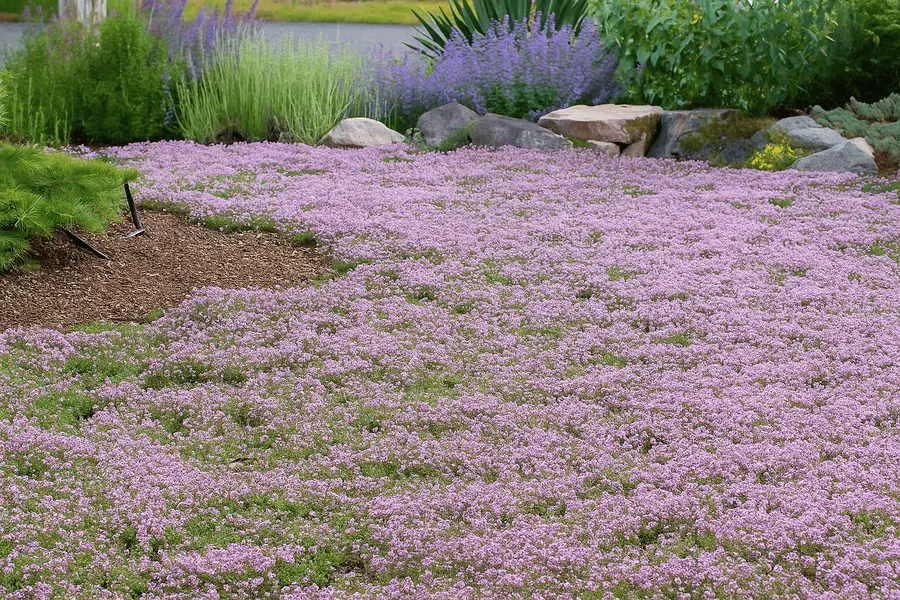
A Mother of Thyme Ground Cover is perfect if you’re tired of patches in your yard or plants that just won’t behave. Bare spots and dry, stubborn soil can really throw off your vibe.
But this low-growing beauty spreads like a soft green carpet, smells incredible, and blooms with color with no stress, just success.
Mother of Thyme Ground Cover Key Takeaways
- Mother of Thyme Ground Cover is a low-growing, spreading herb known for its fragrant leaves and purple-pink summer flowers.
- It’s perfect for filling gaps, covering dry areas, or replacing grass.
- This hardy plant thrives in full sun, needs little water, and creates a soft, walkable mat that looks great and smells even better.
🌿 Mother of Thyme Ground Cover: Beautiful, Tough, and Fragrant
Looking for a charming, low-maintenance plant that smells amazing and thrives where grass gives up?
Meet Mother of Thyme (Thymus serpyllum), a rugged little powerhouse that doubles as a beautiful ground cover and a fragrant herb.
Whether you call it creeping mother of thyme or just want a tidy, green carpet that blooms with pinkish-purple flowers, this plant is a winner.
🌿 What Is Mother of Thyme?
Mother of Thyme is a low-growing herb that spreads like a soft, fragrant carpet.
You’ll also see it called Thymus serpyllum. It’s a woody little perennial that’s part of the mint family, and it’s often mistaken for creeping thyme (Thymus praecox).
But don’t worry—this one stands out with its delicate blooms and tough attitude.
It’s perfect for filling bare spots, spilling over rocks, or lining sunny paths.
🌟 Key Traits:
- Botanical name: Thymus serpyllum
- Height: 2–3 inches tall
- Spread: Up to 18 inches wide
- Zones: USDA 4–9
- Evergreen: In mild climates
- Flowers: Tiny pink or purple blooms in summer
It looks delicate, but don’t be fooled—it thrives in poor soil, loves full sun, and handles drought like a champ.
Thymus serpyllum, known by the common names of Breckland thyme,[3] Breckland wild thyme, wild thyme, creeping thyme, or elfin thyme, is a species of flowering plant in the mint family, Lamiaceae. It is a low, usually prostrate subshrub forming creeping stems up to 10 cm (4 in) tall. The oval evergreen leaves are up to 8 mm. The strongly scented flowers are either lilac, pink-purple, magenta, up to 6 mm long and produced in clusters. https://en.wikipedia.org/wiki/Thymus_serpyllum

🌼 Why Use Mother of Thyme as Ground Cover?
If you’re tired of weeding, watering, or mowing, Mother of Thyme might be your new best friend.
It’s one of those plants that asks for almost nothing, but gives back in a big way.
This little creeper spreads fast, smells amazing, and fills in empty spaces like it was made for the job.
👍 What Makes It So Useful?
- Drought-tolerant: Once it settles in, it barely needs water
-
Weed-smothering: Grows dense enough to block out most weeds
-
Pollinator-friendly: Bees and butterflies love the blooms
- Low-maintenance: Forget mowing—it stays tidy all on its own
- Walkable: Soft underfoot and can handle light foot traffic
- Fragrant: Crush the leaves and enjoy a burst of fresh scent
It’s a go-to choice for gardeners who want beauty without the fuss.
So if you’re tired of mowing, watering, or fighting off weeds, Mother of Thyme ground cover is a dream come true.
It spreads low and wide, forming a thick, cushiony mat that resists foot traffic and thrives in tough spots.
🌱 Mother of Thyme vs. Creeping Thyme
They might look similar at first glance, but Mother of Thyme and Creeping Thyme have their own quirks.
If you’re choosing between them, it helps to know the difference.
Mother of Thyme (Thymus serpyllum) has a softer, looser feel, while Creeping Thyme (Thymus praecox) grows a bit denser and slightly taller.
🔍 Quick Comparison:
| Feature | Mother of Thyme (T. serpyllum) | Creeping Thyme (T. praecox) |
|---|---|---|
| Height | 2–3 inches | 3–6 inches |
| Growth Habit | Airy and fine-textured | Thicker, tighter mat |
| Cold Hardiness | Slightly more cold-tolerant | Tolerates more heat |
| Bloom Color | Pink to lavender | Pink to magenta |
| Foot Traffic | Light foot traffic | Better for paths and patios |
So, which one’s better? That depends on your space. For a softer, natural look, go with Mother of Thyme. Want a dense mat that fills in fast? Creeping Thyme’s your pick.
🌿 How to Grow and Care for Mother of Thyme

You don’t need a green thumb to grow Mother of Thyme. This plant is as easygoing as it gets.
Give it some sun, well-drained soil, and a little space to spread—and it’ll do the rest.
☀️ Light
Loves full sun—6 hours or more a day. That’s when it really shines.
💧 Water
Water regularly while it’s getting settled. After that, it’s happy with dry spells.
🌱 Soil
Well-drained soil is a must. Sandy or rocky works great. It won’t like wet feet.
✂️ Pruning
Snip it back after flowering to keep it neat and encourage more growth.
❄️ Winter Care
In Zones 4–9, it’s a hardy little thing. No extra fuss needed unless the soil stays soggy.
This plant does the work while you enjoy the view and the scent.
Mother of Thyme Plant Care Reference Guide
| Characteristic | Details |
|---|---|
| Common Name | Mother of Thyme |
| Botanical Name | Thymus serpyllum |
| Native Habitat | Europe and North Africa |
| Plant Type | Evergreen perennial herb |
| Growth Pattern | Low-growing, spreading ground cover |
| Mature Size | 2–3 inches tall, spreads up to 18 inches |
| Watering | Low water needs once established |
| Light/Sun Exposure | Full sun (6+ hours daily) |
| Soil Type | Well-drained, sandy or rocky soils |
| Soil pH | Neutral to slightly alkaline (6.5–8.0) |
| Temperature | Tolerates heat and cold; best 60–85°F |
| Humidity | Prefers dry to moderate humidity |
| Bloom Time & Flower Color | Summer, pink to purple flowers |
| Potential Problems | Root rot in poorly drained soil |
| Repotting | Rarely needed; prefers growing in-ground |
| Hardiness Zones (USDA) | Zones 4–9 |
🌱 Planting Tips for Success
Starting Mother of Thyme is simple, and once it takes off, you’ll wonder why you didn’t plant it sooner.
Whether you’re sowing seeds or setting in starts, just follow a few basic steps to get it going strong.
🕰️ Best Time to Plant
- Spring or early fall is ideal
- Avoid peak heat or frost
📏 Spacing
- Space plants 12–18 inches apart
- They’ll fill in fast without choking each other
🌾 Starting from Seed
- Gently press Mother of Thyme seed into the soil
- Don’t bury it—light helps it germinate
- Keep moist until sprouts show
🌿 Using Transplants
- Dig shallow holes
- Water them well the first few weeks
- Mulch lightly to hold in moisture, but don’t smother
Want to go big? Look for Mother of Thyme seeds in bulk and cover large areas for less.
🌸 Landscape Ideas for Mother of Thyme
Need an easy way to brighten up tricky spots in your yard? Mother of Thyme is a garden multitasker.
Whether you’ve got a slope, a path, or just some bare dirt to cover, this plant adds beauty, fragrance, and texture without any extra work.
🌿 Try It Here:
- Between stepping stones – soft underfoot and smells great when you walk on it
- In rock gardens, fills gaps with lush green and pops of color
- On slopes – great for erosion control and tough to beat
- Around patios or decks – adds charm and repels mosquitoes
- As a lawn alternative – no mowing, low water, and always tidy
It’s also a pollinator magnet, so bees and butterflies will love your yard as much as you do.
🛒 Where to Buy Mother of Thyme Plants and Seeds
Ready to get your hands on some Mother of Thyme? Good news, this plant is easy to find, and you’ve got a few solid options depending on your project size and budget.
🌱 Local Options
- Garden centers and nurseries
- Native plant sales
- Farmer’s markets (sometimes!)
🌐 Online Choices
- Amazon
- Etsy plant shops
- Specialty herb growers
- Wildflower seed suppliers
🧺 Buying Tips
- Double-check the botanical name: Thymus serpyllum
- Look for Mother of Thyme plants for sale if you want instant coverage
- Use Mother of Thyme seeds bulk for big areas or budget planting
Start small or go big—either way, it’s one of the easiest ground covers to add to your garden.
❓ Mother of Thyme FAQs
Got questions about Mother of Thyme? You’re not alone. Here are a few common ones people ask before planting this fragrant little powerhouse.
Q. Is Mother of Thyme edible?
A. Yes! It’s a mild culinary herb. While not as strong as common thyme, it’s great for teas, garnishes, and light seasoning.
Q. Can I walk on Mother of Thyme?
A. Absolutely. It can handle light foot traffic, it’s perfect between pavers or along garden paths.
Q. How fast does it spread?
A. Once it’s happy, it spreads at a steady pace. Expect it to fill in within a season or two, depending on spacing.
Q. Is Mother of Thyme safe for pets?
A. Yep! It’s non-toxic to cats and dogs and safe for curious critters.
Q. Can it grow in containers?
A. Sure thing. Just use a shallow pot with good drainage and plenty of sun.
🌟 Final Thoughts: Why Mother of Thyme Deserves a Spot in Your Garden
Mother of Thyme is one of those rare plants that does it all. It spreads beautifully, smells amazing, and handles tough spots like a champ.
Whether you need a lawn alternative, a gap filler, or just a little more green in your life, it fits right in.
🌿 Quick Recap:
- Low-maintenance and drought-tolerant
- Gorgeous summer blooms
- Great for pollinators
- Edible and pet-safe
- Grows where grass won’t
If you’re ready to stop fighting your landscape and start enjoying it, this plant’s got your back.
So go ahead and pick up a few Mother of Thyme plants or seeds, tuck them into the sunniest part of your yard, and let nature do the rest.
Xeriscape Ground Covers: Best Smart Choices for Dry Zones
References
What is Xeriscaping? (Including Best Plants for Your Zone) – Nevada NID
Designing Landscapes for Northern Nevada’s Arid Climate – Nevada Extension
South Texas Wildscape and Xeriscape-plants/ Texas A&M Extension
New Mexico Xeric Guide – NM.Gov
Low Water Use/Drought Tolerant Plant List – Arizona Department of Water Resources
The Beginners Guide to Xeriscape in Denver – 5280 Magazine Denver’s Mile High Magazine
What is xeriscaping? A beginner’s guide to drought-tolerant landscaping – Colorado State University
What is xeriscaping? A beginner’s guide to drought-tolerant landscaping – Colorado State University
UCCE Master Gardeners of San Joaquin County – Low Water Use Landscapes
